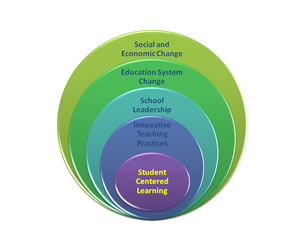Centre for Educational Research and Innovation - CERI
Inspired by Technology, Driven by Pedagogy: A Systemic Approach to Technology-Based School Innovations
Executive summary | Table of contents | How to obtain this publication
|
ISBN: 9789264094437 (PDF);9789264094789 (print) |
|
This book is an attempt to contextualise the issues described above by providing an analytical framework made up of three different sections: the opportunities offered by technology, how technology-based innovations are monitored and assessed, and the role of research in documenting innovations. The first part offers a look at the changing landscape of technology in education and, in particular, to the emergence of the Web 2.0 and digital learning resources to see where the new opportunities and challenges are located. Neil Selwyn’s contribution highlights, from a well-documented perspective, the changes brought about by Web 2.0 in society, the opportunities that schools might benefit from and, sadly, how little use teachers are making of these opportunities. In doing so, he raises once again the issue of the difficulties that schools and teachers face when trying to digest new technological developments. Finally he rightly asks whether society should really expect them to do it without an ongoing dialogue about educational expectations. The second contribution in this section is made by Jan Hylén, formerly at CERI, who summarises the main findings of an OECD report on the production and use of digital learning resources in the five Nordic countries. Hylén’s perspective on this long-awaited development, digital learning resources, is extremely nuanced and raises important questions about the role that governments, public and private providers and the teaching community should play if digital learning resources were to become a standard feature in mainstream education, thus transcending the stage of being yet another technology-based innovation
- Executive summary
Introduction. The need for a systemic approach to technology-based school innovations.
Part I. A changing landscape
- Chapter 1. Web 2.0 and the school of the future, today
- Chapter 2. Can digital learning resources spur innovation?
Part II. How technology-based innovations are monitored, assessed and scaled up
- Chapter 3. Monitoring and assessing the use of ICT in education: The case of Australia.
- Chapter 4. Extending and scaling technology-based innovations through research: The case of Singapore.
Part III. Promising avenues for research
- Chapter 5. The third lever: Innovative teaching and learning research
- Chapter 6. Design research on technology-based innovations
- Conclusion. Lessons learnt and policy implications
|
Figure 5.3. ITL research logic model
|
How to obtain this publication
Readers can access the full version by choosing from the following options:
-
Subscribers and readers at subscribing institutions can access the online edition OECD-iLibrary.
-
Non-subscribers can purchase the PDF e-book and/or paper copy via our Online Bookshop.
-
Order from your local distributor
-
Government officials with accounts () can go to the "Books" tab on OLIS.
Read more about our work
CERI's Activities
CERI - Systemic Innovation in Education
CERI - Digital learning resources as systemic innovation
CERI - Digital learning resources as systemic innovation
Related Documents

